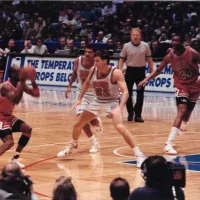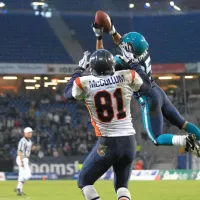The Stanley Cup is the oldest trophy awarded to a professional sports franchise in North America. Commissioned in 1892 by Lord Stanley of Preston, it was initially awarded to Canada's top amateur hockey club, the Montreal Hockey Club, in 1893. Early winners were determined through challenge games and league play. Professional teams became eligible in 1906. By 1915, the National Hockey Association (NHA) and the Pacific Coast Hockey Association (PCHA) agreed that their champions would compete for the Cup. It became the de facto championship trophy of the NHL in 1926 and the de jure NHL championship prize in 1947 and is awarded annually to the NHL playoff champion.
1902: Base Ring Full
In 1902, the original base ring was full, and teams were unable to engrave their names on it.
1906: Professional teams become eligible to challenge for the Stanley Cup
In 1906, professional teams became eligible to challenge for the Stanley Cup. This decision marked a significant shift in the Cup's history, opening it up to professional competition after previously being contested primarily by amateur teams.
January 1907: Kenora Thistles capture the Stanley Cup
In January 1907, the Kenora Thistles, led by Art Ross and "Bad" Joe Hall, won the Stanley Cup. The town's population was approximately 4,000 at the time.
March 1907: Montreal Wanderers challenge Thistles to rematch
In March 1907, the Montreal Wanderers challenged the Kenora Thistles to a Stanley Cup rematch. Despite improving their lineup, the Thistles lost the Cup to Montreal.
1907: Montreal Wanderers engrave names on the bowl
In 1907, the Montreal Wanderers became the first club to record their name on the bowl's interior surface and to record the names of 20 members of their team.
1908: Allan Cup introduced, Stanley Cup becomes symbol of professional supremacy
In 1908, the Allan Cup was introduced as the trophy for Canada's amateurs, leading the Stanley Cup to increasingly represent professional hockey supremacy.
1908: Wanderers Don't Record Names on Cup
In 1908, the Wanderers, despite turning aside four challengers, did not record their names on the Cup for unknown reasons.
1909: Ottawa Senators Added Second Band
In 1909, the Ottawa Senators added a second band onto the Stanley Cup.
1910: Wanderers Do Not Engrave Names
In 1910, the Wanderers did not engrave their names on the Stanley Cup.
1911: Senators Do Not Engrave Names
In 1911, the Senators did not engrave their names on the Stanley Cup.
1912: Stanley Cup defended at end of champion team's regular season
In 1912, it was declared that the Stanley Cup was to be defended only at the end of the champion team's regular season. Previously, challenges could occur at any time or place with appropriate rink conditions.
1914: Controversy over Victoria Aristocrats Stanley Cup challenge
In 1914, a controversy arose when the Victoria Aristocrats' challenge to the Toronto Blueshirts was initially questioned by Stanley Cup trustees. This was due to a misunderstanding regarding formal notification procedures.
1914: Stanley Cup for the best team in the world
In 1914, the trustees of the Stanley Cup formally stated that the Cup was now for the best team in the world, not just the best team in Canada. This followed the inclusion of the American-based Portland Rosebuds in the PCHA.
1914: Winners determined by challenge games and league play
In 1914, winners of the Stanley Cup were determined by challenge games and league play. This was during a period where the Cup's governance and competition format were still evolving.
1914: Combined wins by NHL and non-existent teams
Since the 1914–15 season, the Stanley Cup has been won a combined 106 times by 21 current NHL teams and five teams no longer in existence.
1915: NHA and PCHA agree on Stanley Cup Finals format
In 1915, following the Maritime league's collapse, the NHA and the PCHA established a gentlemen's agreement to have their respective champions compete for the Stanley Cup. This arrangement was similar to baseball's World Series.
1915: NHA and PCHA agree for Stanley Cup
In 1915, the National Hockey Association (NHA) and the Pacific Coast Hockey Association (PCHA), reached an agreement in which their respective champions would face each other annually for the Stanley Cup. This agreement formalized a structured championship series between the two major hockey organizations of the time.
1915: Ottawa Senators Engrave Names on Trophy
In 1915, the Ottawa Senators engraved their names on the trophy even though they did not officially win it under the new PCHA-NHA system.
1915: Vancouver Millionaires Engrave Players' Names
In 1915, the Vancouver Millionaires became the second team to engrave players' names, this time inside the bowl along its sides.
1916: Portland Rosebuds Engrave Names on Trophy
In 1916, the Portland Rosebuds engraved their names on the trophy even though they did not officially win it under the new PCHA-NHA system.
1918: 1918-19 no decision engraved
In 1918, also included was the 1918–19 no decision between the Montreal Canadiens and Seattle Metropolitans.
1918: Millionaires Filled Second Band
In 1918, the Millionaires eventually filled the band added by the 1909 Senators.
1919: Stanley Cup Finals cancelled due to Spanish flu epidemic
In 1919, the Stanley Cup Finals were cancelled due to the Spanish flu epidemic. The Montreal Canadiens and the Seattle Metropolitans were forced to abandon the series after game five, marking the first time the Stanley Cup was not awarded.
1919: Stanley Cup Cancelled Due to Flu Pandemic
In 1919, the Stanley Cup was not awarded for the first time in its history due to the flu pandemic.
1920: National Football League policy on its league champions
In 1920, the then still-fledgling National Football League started a policy from its start, claiming its league champions the world champions, copying the NHL.
1920: Winning team didn't put name on the Stanley Cup.
In 1920, the winning team did not put their team name on the Stanley Cup.
1922: Format for Stanley Cup Finals changed
In 1922, the format for the Stanley Cup Finals was changed. With the creation of the Western Canada Hockey League (WCHL), three leagues competed for the Cup: two league champions faced each other for the right to challenge the third champion in the final series.
1923: Winning team didn't put name on the Stanley Cup.
In 1923, the winning team did not put their team name on the Stanley Cup.
1924: Canadiens add new band to the Cup
In 1924, the Canadiens added a new band to the Stanley Cup, and engraving became an unbroken annual tradition.
1924: Victoria Cougars win the Cup
In 1924, the Victoria Cougars won the Stanley Cup. This was the last team outside the NHL to achieve this feat.
1924: Engraving of winning teams on Stanley Cup begins
In 1924, the tradition of engraving the names of winning players, coaches, management, and club staff on the Stanley Cup began. This practice is unique among major sports trophies, adding a personal and historical dimension to the Cup.
1926: Stanley Cup becomes de facto championship trophy of the NHL
In 1926, the Stanley Cup was established as the de facto championship trophy of the National Hockey League (NHL). This marked a turning point as the NHL gained prominence and the Cup became closely associated with the league.
1926: WHL folds, NHL gains dominance
In 1926, the Western Hockey League (WHL) folded, leading to the NHL acquiring most of its players and expanding into the U.S. with the Chicago Blackhawks, Detroit Cougars (now Detroit Red Wings), and New York Rangers. This established the NHL's prominence.
1932: Possible first Stanley Cup awarded on the ice
In 1932, the Stanley Cup was possibly awarded on the ice for the first time to the Toronto Maple Leafs, although this practice did not become a tradition until the 1950s.
1940: Retiring of band listing 1940-41 champions
After the 2005-06 champion Carolina Hurricanes were crowned, the band listing the 1940-41 champions was retired.
1940: New band added almost every year that the trophy was awarded
Between 1924 and 1940, a new band was added almost every year that the Stanley Cup trophy was awarded, earning the nickname "Stovepipe Cup" due to the unnatural height of all the bands.
1946: National Basketball Association asserted policy on its league champions
In 1946, the National Basketball Association asserted policy on its league champions, claiming its league champions the world champions, copying the NHL.
1947: 1947 Agreement
In 1947, an agreement with the NHL was signed by the cup trustees, which later led to controversy during the 2004-05 NHL lockout.
1947: NHL gains control of the Stanley Cup
In 1947, the NHL reached an agreement with trustee J. Cooper Smeaton, granting the league control over the Stanley Cup. This allowed the NHL to reject challenges from other leagues.
1947: Stanley Cup becomes de jure NHL championship prize
In 1947, the Stanley Cup became the de jure NHL championship prize. This formalized its status as the official championship trophy of the NHL, solidifying the league's control over the Cup.
1947: Cup size reduced
In 1947, the size of the Stanley Cup was reduced, though the large rings were not all the same size.
1947: Stanley Cup Trustees cede control to the NHL
In 1947, the trustees who governed the Stanley Cup ceded control to the NHL. Until 1947, the regulations set down by Lord Stanley called for two trustees, who had the sole, joint right to govern the Cup and the conditions of its awarding.
1948: Stanley Cup redesigned
In 1948, the Stovepipe Cup was redesigned as a two-piece cigar-shaped trophy with a removable bowl and collar to properly honor those teams that did not engrave their names.
1950: Ted Lindsay Hoists Cup Overhead
In 1950, Ted Lindsay of the Detroit Red Wings became the first captain to hoist the Stanley Cup overhead and skate around the rink, setting a new tradition.
1952: Retiring of band listing 1952-53 champions
After the 2005-06 champion Carolina Hurricanes were crowned, the band listing the 1952-53 champions was retired.
1953: 1953-54 to 1964-65 winners band removed
In 2018, the band listing the 1953-54 winners to 1964-65 was removed from the Stanley Cup.
1954: First woman to have name engraved on the Stanley Cup
In 1954, Marguerite Norris was the first woman to have her name engraved on the Stanley Cup as the president of the Detroit Red Wings.
1955: Marguerite Norris's Name Engraved on Stanley Cup
In 1955, Marguerite Norris won the Stanley Cup as the president of the Detroit Red Wings, resulting in her name being engraved on the Cup for the second time.
1958: Modern one-piece Cup design introduced
In 1958, the modern one-piece Stanley Cup design was introduced, replacing the old barrel with a five-band barrel.
November 22, 1961: Amendment to Stanley Cup Agreement
On November 22, 1961, the agreement governing the Stanley Cup was amended, replacing the Governors of the International Hockey Hall of Fame with the Committee of the Hockey Hall of Fame in Toronto as the group responsible for naming the two Canadian trustees.
1963: Creation of the authenticated Presentation Cup
In 1963, the authenticated "Presentation Cup" was created by Montreal silversmith Carl Petersen due to concerns about the original bowl's fragility.
1963: Collar Replaced
In 1963, the original collar of the Stanley Cup was too brittle and was replaced.
1964: 1953-54 to 1964-65 winners band removed
In 2018, the band listing the 1953-54 winners to 1964-65 was removed from the Stanley Cup.
1964: First awarding of the Presentation Cup
The Presentation Cup was first awarded in 1964, after being created in secret by Montreal silversmith Carl Petersen in 1963.
1965: Montreal Canadiens Engraving Anomaly
In 1965, the names of the Montreal Canadiens were engraved over a larger area than allotted.
1965: 1953-54 to 1964-65 winners band removed
In 2018, the band listing the 1953-54 winners to 1964-65 was removed from the Stanley Cup.
1969: Bowl Replaced
In 1969, the original bowl of the Stanley Cup was too brittle and was replaced.
1970: Original Stanley Cup moved to Hockey Hall of Fame
The original 1892 Dominion Hockey Challenge Cup was physically awarded to the Champions until 1970, and is now displayed in the Vault Room at the Hockey Hall of Fame in Toronto, Ontario.
1980: Denis Savard NHL Draft
In 1980, many fans urged the Canadiens to draft Denis Savard.
1987: Gretzky Hands Cup to Smith
In 1987, after the Edmonton Oilers won, Wayne Gretzky handed the Stanley Cup to Steve Smith.
1988: Louise St. Jacques Becomes Stanley Cup Engraver
In 1988, Louise St. Jacques, a Montreal silversmith, became the fourth and current official Stanley Cup engraver.
1989: Sonia Scurfield's name engraved on the Stanley Cup
In 1989, Sonia Scurfield became the only Canadian woman to have her name engraved on the Stanley Cup as a co-owner of the Calgary Flames.
1991: Bands Filled and New Band Added
In 1991, when the bands were all filled, the top band of the large barrel was preserved in the Hockey Hall of Fame, and a new blank band was added to the bottom.
1992: Centennial Year and Band Filling
In 1992, the bands were originally designed to fill up during the Cup's centennial year.
1993: Carbonneau Hands Cup to Savard
In 1993, Guy Carbonneau handed the Stanley Cup to Denis Savard.
1993: Montreal Canadiens win Stanley Cup
In 1993, the Montreal Canadiens won the Stanley Cup, marking the most recent occasion a Canadian-based team has won the trophy.
1993: Creation of the replica Permanent Cup
In 1993, the replica "Permanent Cup" was created by Montreal silversmith Louise St. Jacques to be used as a stand-in at the Hockey Hall of Fame.
1993: Creation of the Permanent Cup at the Hall of Fame
In 1993, the replica "Permanent Cup" was created to be used as a stand-in at the Hockey Hall of Fame whenever the Presentation Cup is not available for display.
1994: Eddie Olczyk's Stanley Cup adventure with Kentucky Derby winner Go for Gin
After the New York Rangers' 1994 Stanley Cup win, Eddie Olczyk brought the Cup to the Belmont Stakes, where Kentucky Derby winner Go for Gin ate out of it.
1994: NHL Permission for Engraving Player Names Under Extenuating Circumstances
Since 1994, teams have been permitted to petition the NHL Commissioner to engrave a player's name on the Stanley Cup if the player was unavailable to play due to "extenuating circumstances".
1995: New Jersey Devils' tradition of individual player possession of the Stanley Cup
In 1995, the New Jersey Devils started a tradition wherein each member of the Cup-winning team is allowed to retain the Stanley Cup for a day. After the 1994–95 season, the NHL mandated the presence of an official Cup handler during player possession.
June 13, 1997: Car accident of Vladimir Konstantinov
On June 13, 1997, Vladimir Konstantinov had a car accident, ending his career.
1998: Vladimir Konstantinov's Name Engraved on Stanley Cup
In 1998, the Detroit Red Wings received special permission from the NHL to inscribe the name of Vladimir Konstantinov on the Stanley Cup after he was unable to play due to a car accident.
March 6, 2000: Ray Bourque Traded to Colorado Avalanche
On March 6, 2000, Ray Bourque was traded to the Colorado Avalanche.
August 22, 2001: Stanley Cup summit on Mount Elbert
On August 22, 2001, Colorado Avalanche Director of Finance Mark Waggoner carried the Stanley Cup to the summit of Mount Elbert, the highest point of Colorado.
2001: Charlotte Grahame's Name Engraved on Stanley Cup
In 2001, Charlotte Grahame, the Colorado Avalanche's Senior Director of Hockey Administration, had her name engraved on the Stanley Cup.
2001: Sakic hands the Cup to Bourque
In 2001, after the Colorado Avalanche won the Cup, Joe Sakic handed the Stanley Cup to Ray Bourque, marking the end of Bourque's 22-year NHL career and his first Cup victory.
2002: Popular use of the term Triple Gold Club
Following the 2002 Winter Olympics, the term "Triple Gold Club" entered popular use with the addition of the first Canadian members.
2004: 2004-05 NHL Lockout
Following the 2004-05 season, a new band was scheduled to be added to the bottom of the Stanley Cup, but it was delayed due to the 2004-05 NHL lockout.
2004: John Grahame's Name Engraved on Stanley Cup
In 2004, John Grahame had his name engraved on the Stanley Cup as a member of the Tampa Bay Lightning.
2004: Cancellation of the 2004-05 NHL season
In 2004, a labor dispute between the NHL owners and the NHL Players Association led to the cancellation of the 2004-05 season, resulting in no Stanley Cup champion being crowned for the first time since 1919.
2004: 2004 NHL lockout leads to dispute about the Stanley Cup
In 2004, an NHL lockout commenced, leading to dispute about whether the Stanley Cup trustees were obliged to award the trophy regardless of the lockout.
2004: Stanley Cup display at MacDill Air Force Base
In 2004, the Stanley Cup was displayed at MacDill Air Force Base near Tampa, Florida, serving as a morale booster for the troops.
2005: "2004–05 Season Not Played" added to Stanley Cup
After the 2005-06 champion Carolina Hurricanes were crowned, and the new bottom ring was added, the cancelled 2004–05 season was acknowledged with the words "2004–05 Season Not Played".
2005: NHL Lockout and Stanley Cup Controversy
In 2005, due to a labor dispute between the NHL owners and the NHL Players Association, the 2004-05 season was cancelled. This marked the first time since 1919 that no Stanley Cup champion was crowned, leading to fan controversy and alternative proposals such as awarding the Cup to the top women's hockey team.
2005: Stanley Cup not awarded due to NHL lockout
In 2005, the Stanley Cup was not awarded due to the 2004–05 NHL lockout. This was the second time in its history that the Cup was not presented to a champion.
2005: Stanley Cup goes unclaimed for 2004-05
In 2005, the Stanley Cup went unclaimed for the 2004-05 season, due to the NHL lockout.
February 7, 2006: Settlement reached on Stanley Cup awarding
On February 7, 2006, a settlement was reached stating the Stanley Cup could be awarded to non-NHL teams if the NHL did not operate for a season. However, the NHL resumed operations for the 2005-06 season, and the Stanley Cup remained unclaimed for the 2004-05 season.
2006: Stanley Cup tour of Marine Corps Base Camp Lejeune
In 2006, the Stanley Cup toured Marine Corps Base Camp Lejeune, North Carolina, where wounded Marines had the opportunity to view and be photographed with the Cup.
2007: IIHF Formalizes the Triple Gold Club
In 2007, the International Ice Hockey Federation (IIHF) formalized the "Triple Gold Club", which recognizes players and coaches who have won an Olympic Games gold medal, a World Championship gold medal, and the Stanley Cup.
2007: Stanley Cup's first trip to a combat zone in Afghanistan
In 2007, the Stanley Cup made its first trip into a combat zone, visiting Kandahar, Afghanistan from May 2 to 6. The Cup was put on display for Canadian and other NATO troops during the trip organized by the NHL, the Hockey Hall of Fame, the NHL Alumni and the Canadian Department of National Defence.
March 2008: Stanley Cup visit to Afghanistan as part of Team Canada visit
In March 2008, the Stanley Cup was returned to Afghanistan as part of a "Team Canada visit".
2008: Detroit Red Wings win Stanley Cup
In 2008, the Detroit Red Wings won the Stanley Cup. This marked the most recent win for any United States-based NHL team.
June 27, 2010: Stanley Cup appearance at Chicago Gay Pride Parade
On June 27, 2010, Chicago Blackhawks defenceman Brent Sopel paid tribute to his friend, former Toronto Maple Leafs general manager Brian Burke and Burke's late son, Brendan, by accompanying the Stanley Cup to the 2010 Chicago Gay Pride Parade.
2010: Stanley Cup's fourth trip to Afghanistan
In the spring of 2010 the Stanley Cup made its fourth trip to Afghanistan, accompanied by ex-players.
2012: NHL Lockout and Stanley Cup Challenges
In 2012, another NHL lockout commenced, and the trustees stated the 2006 agreement did not oblige them to award the Cup in the event of a lost season.
March 2017: Stanley Cup 125th Anniversary Commemoration
In March 2017, to commemorate the Stanley Cup's 125th anniversary, the original Cup and the current Stanley Cup were the focus of a four-day tour of Ottawa, including a stop at Rideau Hall. The Royal Canadian Mint also produced two commemorative coins to mark the anniversary.
October 2017: Lord Stanley's Gift Monument Erected
In October 2017, the Lord Stanley's Gift Monument was erected in Ottawa, commemorating the donation of the Stanley Cup.
2017: Over 3,000 names engraved on the Stanley Cup
By 2017, more than 3,000 different names, including the names of over 1,300 players, had been engraved on the Stanley Cup.
2017: Stanley Cup's 125th Anniversary Stats
By its 125th anniversary in 2017, the Stanley Cup stood at 89.5 centimetres tall, weighed 15.5 kilograms, and had 3,177 names engraved on it, with 1,331 belonging to players.
2017: Washington Capitals win Stanley Cup
In 2017, the Washington Capitals won the Stanley Cup, leading to the band listing the 1953-54 to 1964-65 winners being removed in September 2018.
September 2018: Band Removal and Addition to Stanley Cup
In September 2018, following the crowning of the 2017–18 champions, the Washington Capitals, the band listing the 1953–54 to 1964–65 winners was removed, and a new band for the 2017–18 to 2029–30 champions was added to the bottom of the cup.
2018: Stanley Cup used to support Humboldt Broncos and Capital Gazette
In 2018, the Stanley Cup was used to improve the spirits of those affected by the Humboldt Broncos' bus crash on April 6 and the Capital Gazette shooting on June 28.
2023: Ian 'Scotty' Morrison retires as Stanley Cup trustee
In 2023, Ian "Scotty" Morrison retired as trustee. While the original regulations allow for a trustee to resign, to date, only Ian "Scotty" Morrison retired as trustee in 2023. All other trustees have served until their deaths.
2024: Florida Panthers win Stanley Cup
In 2024, the Florida Panthers won the Stanley Cup for the first time in franchise history.
2024: Value of the original Stanley Cup in 2024 dollars
In 2024, the cost of the Stanley Cup from when Lord Stanley of Preston purchased it is equal to $1,703.
2029: New band added for 2017-18 to 2029-30 champions
In 2018, a new band was added to the Stanley Cup for the 2017-18 to 2029-30 champions.
Mentioned in this timeline

Basketball is a team sport played on a rectangular court...

Wayne Gretzky a Canadian former professional ice hockey player widely...

Los Angeles is the most populous city in California and...

Football is a family of team sports primarily involving kicking...

Seattle is the most populous city in Washington state and...
North Carolina is a Southeastern U S state the th-largest...
Trending

Gene Simmons also known as The Demon was the bassist and co-lead singer of the rock band Kiss He co-founded...
26 days ago New handbag, dishes, snacks, drinks, and holiday mocktails appear at Disney Springs.

6 months ago Ron Howard Reflects on 'The Studio' Scene with Bryan Cranston, Sarah Polley, and Dave Franco.
5 months ago Millennials Revolt: Coffee Badging Protests Return to Office Policies, Workplace Trends Emerge

7 months ago Koepka and DeChambeau attend Ryder Cup dinner, Bradley sees new side of golf.

9 months ago Cody Rhodes Crushes John Cena After Promo Battle on WWE Raw, March 31, 2025
Popular

Tucker Carlson is an American conservative political commentator known for...

Candace Owens is an American conservative political commentator and author...

XXXTentacion born Jahseh Dwayne Ricardo Onfroy was a controversial yet...

Ben Shapiro is a prominent American conservative political commentator media...

William Franklin Graham III commonly known as Franklin Graham is...

John F Kennedy JFK was the th U S President...
